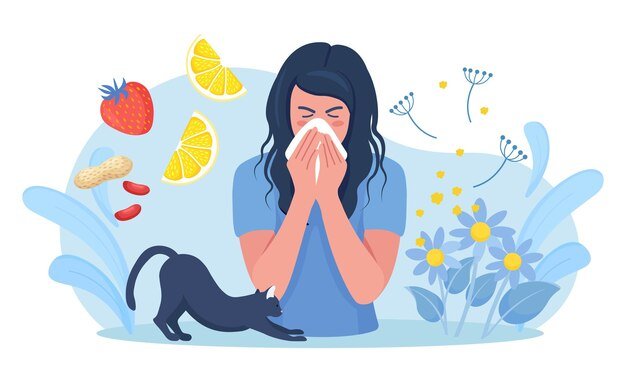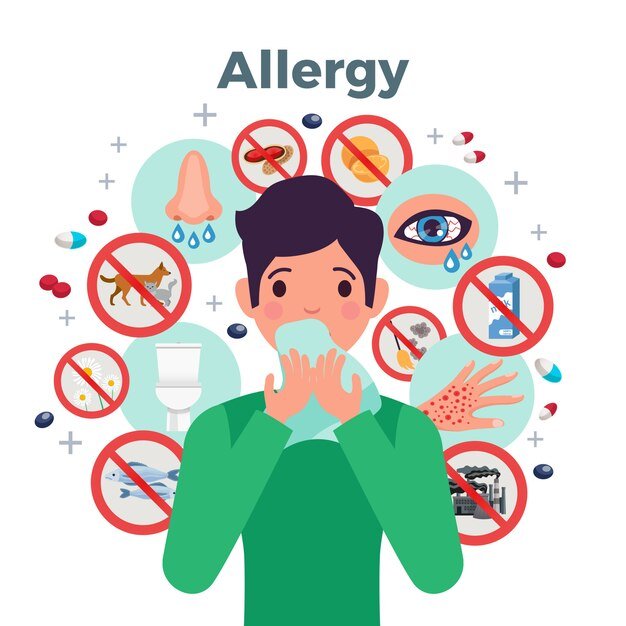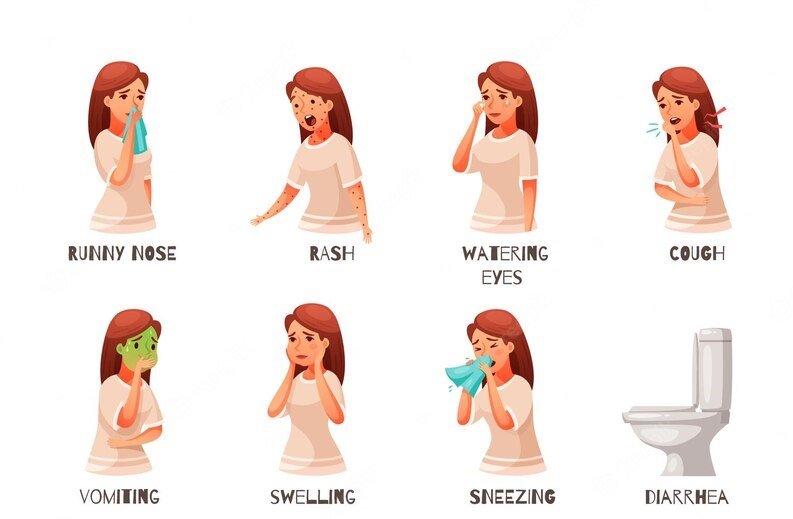If you are wondering about the differences between Allegra Hives Vs Allegra, this article is for you. Briefly put, Allegra Hives provides targeted relief from itching and discomfort caused by hives, while regular Allegra offers broader allergy symptom alleviation.
Dealing with allergies can be a daunting task, but thankfully, there are medications like Allegra that offer relief. However, in the world of antihistamines, there’s a distinction between “Allegra hives” and the regular version of Allegra that might not be immediately clear. This article aims to demystify the differences between these two variants of Allegra, enabling you to make a well-informed choice for your allergy or hives-related discomfort.
Understanding Allergies: An Introduction

Allergies are the body’s immune system’s response to substances that it perceives as harmful, even though they might be harmless to others. These substances, known as allergens, can range from pollen and dust mites to certain foods and pet dander. When an allergic individual comes into contact with an allergen, their immune system triggers a reaction, often leading to symptoms like sneezing, itching, rashes, and more. It’s crucial to recognize and manage allergies to ensure a better quality of life. In this article, we’ll delve deeper into the world of allergies, exploring their causes, symptoms, and possible treatments.
Understanding Allegra
Allegra, scientifically known as fexofenadine, is categorized as a second-generation antihistamine. Antihistamines work by blocking the action of histamines in the body, which are chemicals released during an allergic reaction that trigger various symptoms like itching, sneezing, and a runny nose. Allegra specifically targets these symptoms and helps alleviate them, providing a reprieve from the discomfort of allergies.
What Are Hives?
Hives, scientifically referred to as urticaria, are essentially an allergic reaction manifesting on the skin. They are characterized by red, raised welts that can be intensely itchy. Hives are typically caused by the release of histamines in response to allergens such as certain foods, medications, insect bites, or environmental factors. The appearance of hives can vary in size and shape, and they often appear suddenly.
Allegra for Allergies
Regular Allegra is designed to combat a wide spectrum of allergy symptoms. Whether you’re facing a pollen onslaught, pet dander invasion, or dust mite congregation, Allegra is equipped to counteract the effects of histamine release. By doing so, it addresses sneezing, itching, runny noses, and other symptoms that can make life during allergy season a challenge.
Allegra for Hives
Allegra formulated for hives, on the other hand, zooms in on a specific issue: the itchiness and discomfort that hives bring. This variant of Allegra zeros in on the histamine response triggered by hives, providing much-needed relief from the incessant itch and inflammation that can accompany this condition. It’s particularly beneficial for individuals grappling with acute or chronic hives, making it a targeted solution.
Key Differences Between Allegra and Allegra Hives

Allegra Hives Vs Allegra: Effectiveness
Allegra
- Versatility is its forte, as it addresses a broad range of allergy symptoms.
- Provides relief from sneezing, itching, runny nose, and watery eyes caused by various allergens.
Allegra Hives
- Specialized in tackling the itching and discomfort linked to hives, providing targeted relief.
- Focuses primarily on alleviating the itchiness and inflammation associated with hives.
Allegra Hives Vs Allegra: Ingredients
Allegra
- Anchored by fexofenadine as its active ingredient.
- Fexofenadine works to block histamine release and alleviate allergy symptoms.
Allegra Hives
- Also harnesses the power of fexofenadine, but with potential tweaks in formulation for enhanced efficacy against hives.
- The formulation may be adjusted to specifically target the histamine response triggered by hives.
Allegra Hives Vs Allegra: Dosage and Usage
Allegra
- Typically taken once a day to maintain consistent relief.
- One dose effectively provides coverage for a full day, helping individuals manage their allergies.
Allegra Hives
- Dosage and frequency may be tailored to the severity of hives, as directed by a healthcare professional.
- The healthcare provider may recommend adjustments based on the individual’s hives condition.
Allegra Hives Vs Allegra: Precautions
Allegra
- Generally well-tolerated, but individual reactions can vary.
- Suitable for most individuals without requiring specialized precautions.
Allegra Hives
- Given the specific nature of hives, consulting a medical professional is advisable, especially for persistent or severe cases.
- A healthcare provider can assess the severity of hives and recommend the appropriate course of action.
Allegra Hives Vs Allegra: Suitability for Different Individuals
Allegra
- Suitable for a wide range of allergies, making it a versatile choice.
- Effective against various allergens, making it a go-to option for seasonal and environmental allergies.
Allegra Hives
- Tailored specifically for those grappling with hives, offering a targeted solution for a distinct issue.
- Ideal for individuals dealing with acute or chronic hives triggered by allergic reactions.
Allegra Hives Vs Allegra: Side Effects

Regular Allegra
- Headache: Some individuals may experience mild to moderate headaches as a side effect of taking regular Allegra.
- Dizziness: Dizziness or lightheadedness could occur, especially when standing up quickly after taking the medication.
- Dry Mouth: A common side effect is a feeling of dryness in the mouth or throat.
- Nausea: While not very common, some users might experience mild nausea after taking Allegra.
- Upset Stomach: Digestive issues like an upset stomach or mild stomach pain can occur in certain cases.
These side effects are usually temporary and mild. However, if they persist or worsen, it’s advisable to consult a medical professional.
Allegra for Hives
- Localized Reactions: Since Allegra for hives is designed to target skin-related allergic reactions, localized side effects like skin irritation or redness might occur.
- Headache: Similar to regular Allegra, headache is a potential side effect of the hives-specific variant.
- Dizziness: Dizziness or lightheadedness can also be experienced by some individuals.
- Dry Mouth: Just like with regular Allegra, dry mouth might be a mild side effect.
- Nausea: While not very common, some users might experience mild nausea after taking Allegra for hives.
It’s important to note that these side effects are not exhaustive and can vary from person to person. If you experience severe or persistent side effects, it’s recommended to seek medical attention.
Consulting a Medical Professional
Before embarking on a new medication journey, it’s wise to confer with a healthcare professional. They possess the expertise to guide you towards the most suitable choice between regular Allegra and Allegra for hives based on your individual health profile and needs.
Allegra Hives Vs Allegra: Cost Comparison
In terms of cost, the price tag attached to Allegra and Allegra for hives can fluctuate based on variables such as geographical location, pharmacy policies, and insurance coverage. Generally, due to its specialized nature, the hives-specific variant might command a slightly higher price.
User Experiences and Reviews
User experiences can provide valuable insights. Some individuals might find one version more effective than the other for their specific symptoms. Navigating user reviews and seeking advice from medical professionals can aid in making an informed decision.
Allegra Hives Vs Allegra: Pros and Cons

Regular Allegra
Pros
- Versatile: Regular Allegra effectively addresses a wide range of allergy symptoms, including sneezing, runny nose, and itchy eyes.
- Non-Sedating: It is classified as a non-sedating antihistamine, meaning it doesn’t typically cause drowsiness or impair cognitive function.
- Once-Daily Dosing: A single daily dose provides consistent relief throughout the day, making it convenient for busy schedules.
- Fast Onset: Many users report experiencing relief within an hour of taking Allegra.
- Over-the-Counter Availability: Regular Allegra is available without a prescription in most places, making it easily accessible.
Cons
- Common Side Effects: While generally well-tolerated, side effects such as headaches, dizziness, and dry mouth can occur.
- Limited Effect on Hives: Regular Allegra might not be as effective in alleviating the specific itchiness and inflammation associated with hives.
Allegra for Hives
Pros
- Targeted Relief: Allegra for hives is specifically formulated to provide relief from the itching and discomfort caused by hives.
- Localized Action: It addresses allergic reactions on the skin, offering relief precisely where it’s needed.
- Non-Sedating: Similar to regular Allegra, the hives-specific version is typically non-sedating.
- Fast Relief: Users often experience rapid relief from hives-related symptoms, making it suitable for acute situations.
- Suitable for Chronic Hives: Individuals with chronic hives can find consistent relief from the persistent itching.
Cons
- Localized Reactions: Some users might experience skin irritation or redness at the application site.
- Potential Side Effects: Similar to regular Allegra, side effects like headaches, dizziness, and dry mouth can occur.
- Specific Application: Allegra for hives is tailored for hives-related symptoms and might not be as effective for other allergy symptoms.
- Ultimately, the choice between regular Allegra and Allegra for hives depends on individual needs and preferences.
Allegra Hives Vs Allegra: Conclusion
In conclusion, Allegra and Allegra for hives each have their unique roles to play in the realm of allergy relief. While regular Allegra serves as a versatile solution for a variety of allergy-related discomforts, Allegra for hives steps up to alleviate the specific itchiness and inflammation associated with hives. Consulting a medical professional remains pivotal to determine the most fitting choice based on your distinct circumstances.
[youtube https://www.youtube.com/watch?v=ehjWazz39zc?si=KKTx2M_SGT9dtQG2&w=560&h=315]Allegra Hives Vs Allegra: FAQs
Why is Allegra for hives different?
Allegra for hives is specifically formulated to target the itching and discomfort associated with hives. Unlike regular Allegra, which addresses a wide range of allergy symptoms, Allegra for hives contains ingredients and a formulation tailored to provide rapid relief from the specific histamine response causing hives. This specialized formulation focuses on alleviating the localized symptoms of hives, making it a targeted solution for those dealing with this skin condition.
Does regular Allegra work for hives?
Regular Allegra might offer some relief from hives due to its antihistamine properties, which can help reduce itching and inflammation. However, it might not be as effective as Allegra for hives, which is specifically designed to address the unique characteristics of hives and provide targeted relief. If you’re experiencing persistent or severe hives, consulting a healthcare professional for guidance on the most appropriate treatment is recommended.
What is the strongest antihistamine for hives?
There isn’t a single “strongest” antihistamine for hives that applies to everyone, as individual responses to medications can vary. However, some antihistamines, including Allegra for hives (fexofenadine), Zyrtec (cetirizine), and Xyzal (levocetirizine), are often considered effective options for managing hives. The best choice depends on factors such as your medical history, tolerance to the medication, and the severity of your hives. Consulting a healthcare professional can help determine the most suitable option for you.
What is the generic brand of Allegra for hives?
The generic name for Allegra for hives is fexofenadine, which is also the active ingredient in both regular Allegra and the hives-specific version. Fexofenadine is available in various generic forms and is widely used to manage allergic reactions, including hives.
Is Allegra for hives the same as Benadryl?
No, Allegra for hives and Benadryl are not the same. While both are antihistamines, they contain different active ingredients. Allegra for hives contains fexofenadine, which is known for its non-sedating properties. On the other hand, Benadryl contains diphenhydramine, an antihistamine that can cause drowsiness. Each medication has its own set of benefits and potential side effects, and the choice between them depends on individual needs and preferences.
Who should not take Allegra for hives?
Individuals who are allergic to fexofenadine or any other ingredients in Allegra for hives should not take this medication. Additionally, pregnant or breastfeeding individuals should consult a healthcare professional before using any medication, including Allegra for hives, to ensure its safety for both themselves and their baby.
What’s better for hives, Benadryl or Allegra?
The choice between Benadryl and Allegra for hives depends on factors such as the severity of your hives and your personal preferences. Benadryl (diphenhydramine) may provide quicker relief from itching, but it can cause drowsiness. Allegra for hives (fexofenadine) is non-sedating and provides targeted relief from hives-related symptoms. Consulting a healthcare professional can help determine which medication is better suited for your specific situation.
Why is Allegra not working on hives?
If Allegra is not effectively relieving your hives, it could be due to factors such as the severity of your condition, individual response to the medication, or other underlying factors. In such cases, it’s advisable to consult a healthcare professional who can assess your situation and recommend potential adjustments to your treatment plan.
Is Zyrtec or Allegra better for hives?
Both Zyrtec (cetirizine) and Allegra for hives (fexofenadine) are commonly used antihistamines for managing hives. The choice between them depends on individual response and factors like personal tolerance and potential side effects. Both medications have their own advantages, and consulting a healthcare professional can help determine which one might be more suitable for your hives.
How long does it take for Allegra to work for hives?
Allegra for hives (fexofenadine) is known for its fast onset of action. Many users report experiencing relief within an hour of taking the medication. However, individual responses can vary, and consistent use as prescribed by a healthcare professional is recommended for optimal results.
Is Allegra better than Claritin for hives?
Both Allegra for hives (fexofenadine) and Claritin (loratadine) are effective antihistamines used to manage hives. The choice between them depends on factors such as individual response, potential side effects, and personal preferences. Consulting a healthcare professional can help determine which medication might be better suited to your needs.
What pill is best to get rid of hives?
The best pill to get rid of hives depends on individual factors. Antihistamines like Allegra for hives (fexofenadine), Zyrtec (cetirizine), and Claritin (loratadine) are commonly used to alleviate hives. Consulting a healthcare professional can help identify the most suitable option for your specific condition.
Does Allegra for hives stop itching?
Yes, Allegra for hives (fexofenadine) is designed to target the itching and discomfort associated with hives. Its antihistamine properties help reduce the histamine response that triggers itching, providing relief from the persistent itchiness caused by hives.
Is Allegra 180 good for hives?
Allegra 180 refers to a higher dosage of fexofenadine, the active ingredient in Allegra for hives. While it can potentially provide stronger relief, it’s important to consult a healthcare professional before adjusting your dosage. They can help determine the appropriate dosage based on your individual needs and medical history.
How much Allegra can I take for chronic hives?
The recommended dosage of Allegra for chronic hives (urticaria) can vary based on individual factors. Generally, the standard dosage is 180 mg per day for adults. However, it’s crucial to consult a healthcare professional before using higher doses or making any changes to your treatment plan, especially for chronic conditions. They can provide personalized guidance based on your specific situation.
References
- PubMed: https://pubmed.ncbi.nlm.nih.gov/
- WebMD: https://www.webmd.com/
- Mayo Clinic: https://www.mayoclinic.org/
- American Academy of Allergy, Asthma & Immunology (AAAAI): https://www.aaaai.org/
- American College of Allergy, Asthma & Immunology (ACAAI): https://acaai.org/

